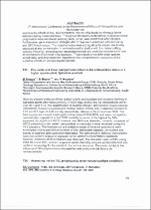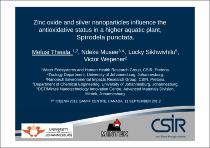 ResearchSpace
ResearchSpace
Zinc oxide and silver nanoparticles influence the antioxidative status in a higher aquatic plant, Spirodela punctata
JavaScript is disabled for your browser. Some features of this site may not work without it.
- ResearchSpace
- →
- Research Publications/Outputs
- →
- Conference Publications
- →
- View Item
| dc.contributor.author |
Thwala, Melusi

|
|
| dc.contributor.author |
Musee, N

|
|
| dc.contributor.author |
Wepener, V

|
|
| dc.date.accessioned | 2013-01-29T12:13:25Z | |
| dc.date.available | 2013-01-29T12:13:25Z | |
| dc.date.issued | 2012-09 | |
| dc.identifier.citation | Thwala, M., Musee, N., and Wepener, V. 2012. Zinc oxide and silver nanoparticles influence the antioxidative status in a higher aquatic plant, Spirodela punctata. 7th International Conference on the Environmental Effects of Nanoparticles and Nanomaterials, Banff, Alberta, Canada, 10-12 September 2012 | en_US |
| dc.identifier.uri | http://hdl.handle.net/10204/6490 | |
| dc.description | 7th International Conference on the Environmental Effects of Nanoparticles and Nanomaterials, Banff, Alberta, Canada, 10-12 September 2012 | en_US |
| dc.description.abstract | The authors present evidence of free radical activity and resultant anti-oxidative defence in Spirodela plants after exposure to 0.01-1000 mg/L of ZnO and Ag nanoparticles (NPs) over 96-h and 14-d. The quantification of reactive nitrogen and reactive oxygen species (RNS/ROS) revealed elevated (a=0.05) free radical activity only in samples exposed to 0.01 and 0.1 mg/L of ZnO and Ag, respectively, relative to the control over 96-h. The 14-d exposures showed most significant increase of RNS/ROS, and were nanoparticle concentration dependent whilst 100% mortality occurred at the highest Ag NPs exposure. No significant H202 increase over 96-h was observed, however, increases of H202 production under certain nanoparticle concentrations were recorded during the 14-d exposure. The biochemical anti-oxidative status of the plant specimens were investigated using quantitative analysis of total antioxidant capacity, peroxidase and activity of catalase and superoxide dismutase. The anti-oxidative defence mechanisms were non-uniform relative to exposure period and NPs concentration variations; however, evidence of NPs influence was observed. The characterization of NPs using TEM, DLS and XRD, and also exposure water chemistry analysis yielded data that was useful in accounting for the resultant biochemical response. The study highlights the influence of NPs physicochemical properties and environmental factors on nanoecotoxicity. | en_US |
| dc.language.iso | en | en_US |
| dc.relation.ispartofseries | Workflow;10155 | |
| dc.subject | Spirodela plants | en_US |
| dc.subject | Nanoparticles | en_US |
| dc.subject | Nanomaterials | en_US |
| dc.subject | Nanomaterials environmental effects | en_US |
| dc.title | Zinc oxide and silver nanoparticles influence the antioxidative status in a higher aquatic plant, Spirodela punctata | en_US |
| dc.type | Conference Presentation | en_US |
| dc.identifier.apacitation | Thwala, M., Musee, N., & Wepener, V. (2012). Zinc oxide and silver nanoparticles influence the antioxidative status in a higher aquatic plant, Spirodela punctata. http://hdl.handle.net/10204/6490 | en_ZA |
| dc.identifier.chicagocitation | Thwala, Melusi, N Musee, and V Wepener. "Zinc oxide and silver nanoparticles influence the antioxidative status in a higher aquatic plant, Spirodela punctata." (2012): http://hdl.handle.net/10204/6490 | en_ZA |
| dc.identifier.vancouvercitation | Thwala M, Musee N, Wepener V, Zinc oxide and silver nanoparticles influence the antioxidative status in a higher aquatic plant, Spirodela punctata; 2012. http://hdl.handle.net/10204/6490 . | en_ZA |
| dc.identifier.ris | TY - Conference Presentation AU - Thwala, Melusi AU - Musee, N AU - Wepener, V AB - The authors present evidence of free radical activity and resultant anti-oxidative defence in Spirodela plants after exposure to 0.01-1000 mg/L of ZnO and Ag nanoparticles (NPs) over 96-h and 14-d. The quantification of reactive nitrogen and reactive oxygen species (RNS/ROS) revealed elevated (a=0.05) free radical activity only in samples exposed to 0.01 and 0.1 mg/L of ZnO and Ag, respectively, relative to the control over 96-h. The 14-d exposures showed most significant increase of RNS/ROS, and were nanoparticle concentration dependent whilst 100% mortality occurred at the highest Ag NPs exposure. No significant H202 increase over 96-h was observed, however, increases of H202 production under certain nanoparticle concentrations were recorded during the 14-d exposure. The biochemical anti-oxidative status of the plant specimens were investigated using quantitative analysis of total antioxidant capacity, peroxidase and activity of catalase and superoxide dismutase. The anti-oxidative defence mechanisms were non-uniform relative to exposure period and NPs concentration variations; however, evidence of NPs influence was observed. The characterization of NPs using TEM, DLS and XRD, and also exposure water chemistry analysis yielded data that was useful in accounting for the resultant biochemical response. The study highlights the influence of NPs physicochemical properties and environmental factors on nanoecotoxicity. DA - 2012-09 DB - ResearchSpace DP - CSIR KW - Spirodela plants KW - Nanoparticles KW - Nanomaterials KW - Nanomaterials environmental effects LK - https://researchspace.csir.co.za PY - 2012 T1 - Zinc oxide and silver nanoparticles influence the antioxidative status in a higher aquatic plant, Spirodela punctata TI - Zinc oxide and silver nanoparticles influence the antioxidative status in a higher aquatic plant, Spirodela punctata UR - http://hdl.handle.net/10204/6490 ER - | en_ZA |






